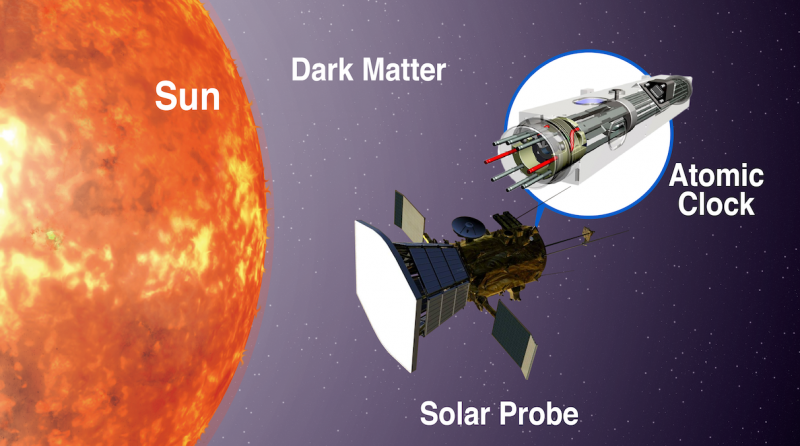Analyzing an atomic clock onboard a spacecraft within the orbit of Mercury and very close to the Sun could be the trick to revealing the nature of dark matter according to a new research article published in the December 5th issue of the journal Nature Astronomy.

Artist's impression of a space atomic clock used to uncover dark matter. Image Credit: Kavli IPMU.
Dark matter composes over 80% of the mass in the universe, but it has thus far dodged detection on Earth, regardless of decades of experimental endeavors. A core component of these hunts is a hypothesis regarding the local density of dark matter, which establishes the number of dark matter particles moving via the detector at all times and thus the experimental sensitivity.
In a few models, this density can be a lot higher than is typically supposed, and dark matter can become more intense in certain regions than in others.
One vital group of experimental searches is those using nuclei or atoms because these have realized extraordinary sensitivity to signals of dark matter. This is conceivable, in part, because when dark matter particles have extremely small masses, they prompt oscillations in the very constants of nature.
These oscillations, for example the interaction strength of the electromagnetic force or in the mass of the electron, alter the transition energies of nuclei and atoms in foreseeable ways.
An international group of scientists, Kavli Institute for the Physics and Mathematics of the Universe (Kavli IPMU) Project Researcher Joshua Eby, University of California, Irvine, Postdoctoral Fellow Yu-Dai Tsai, and University of Delaware Professor Marianna S. Safronova, recognized the potential in these oscillating signals.
They stated that in a specific region of the Solar System, between the orbit of Mercury and the Sun, the dark matter’s density could be exceptionally large, which would mean extraordinary sensitivity to the oscillating signals.
These signals could be captured by atomic clocks, which work by meticulously measuring the frequency of photons discharged in transitions of various states in atoms. Ultralight dark matter in the region of the clock experiment could alter those frequencies as the oscillations of the dark matter marginally increase and decrease the photon energy.
The more dark matter there is around the experiment, the larger these oscillations are, so the local density of dark matter matters a lot when analyzing the signal.
Joshua Eby, Project Researcher, Kavli Institute for the Physics and Mathematics of the Universe
While the accurate density of the dark matter near the Sun is not established, the scientists debate that even a comparatively low-sensitivity search could deliver crucial information.
The density of dark matter is just constrained in the Solar System by information concerning planet orbits. In the region between the Sun and Mercury, the planet closest to the Sun, there is nearly no constraint. Therefore, a measurement onboard a spacecraft could rapidly expose world-leading restrictions on dark matter in these models.
The technology to test their theory is already present. Eby says the NASA Parker Solar Probe, which has been functioning since 2018 with the help of shielding, has moved closer to the Sun than any manmade craft in history and is at present working within the orbit of Mercury, with plans to travel even closer to the Sun in a year.
Atomic clocks in space are already established for numerous reasons other than hunting for dark matter.
Long-distance space missions, including possible future missions to Mars, will require exceptional timekeeping as would be provided by atomic clocks in space. A possible future mission, with shielding and trajectory very similar to the Parker Solar Probe, but carrying an atomic clock apparatus, could be sufficient to carry out the search.
Joshua Eby, Project Researcher, Kavli Institute for the Physics and Mathematics of the Universe
More from AZoQuantum: Precise Atomic Clock Proves Einstein was Right on Time
Journal Reference
Tsai, Y-D., et al. (2022) Direct detection of ultralight dark matter bound to the Sun with space quantum sensors. Nature Astronomy. doi.org/10.1038/s41550-022-01833-6.